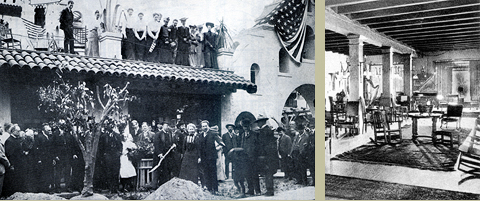
Left: President Roosevelt re-planting one of the two original navel orange trees in front of the Mission Inn, May 8, 1903. Right: The lobby of the new Mission Inn, in 1905 after complete reconstruction of the original Glenwood Hotel by Frank Miller.
Frank Augustus Miller
Frank Miller came to Riverside as a 17 year old. His father, Captain Christopher Columbus “C.C.” Miller, had been drawn to the town to work on the surveying and construction of a canal.
Miller bought the block bounded by Main Street, Sixth Street, Orange Street, and Seventh Street. The home he built, called Glenwood Cottage, grew to take in paying guests. The first paying guest was Albert S. White. On February 4, 1880, C. C. Miller and his wife, Mary, sold the property to their son, Frank, for $5,000.
In 1880, Frank, already a business owner having built the Blue Front Grocery store on Main Street, bought the family home from his father for $5,000. The same year he married Isabelle Hardenburg.
Immediately after acquiring the property Miller landscaped the grounds and planted pepper trees around the block. In 1882, at a cost of $10,000, he built a “large … wooden, two-storied plain addition” to the west side of the adobe home, “extending towards Main Street and adding thirty new guest rooms with openings onto side porches.”
Although Miller advertised it vigorously, the hotel’s early years were difficult. In 1885 he leased the “Glenwood Cottages,” as the hotel was then called, to his sister Alice and her husband, Frank W. Richardson. The regular hotel advertisement had an addendum “For Sale. Hotel Glenwood Property. Furniture and Business is offered for sale at a bargain as the proprietor wishes to retire from the hotel business.” In all probability Miller intended to concentrate on the booming real estate market, but his reputation as a hotel man kept after him.
A little known guest of the Glenwood in the 1880s, Wilson Crewdson, had a significant impact on Miller and the Riverside community. A wealthy Englishman and former director of Oriental exhibits at the British Museum, Crewdson came to Riverside for relief of a lung ailment. “According to Miller’s biographers, Crewdson’s casual conversations with the proprietor of the Glenwood Hotel-about art, history, and culture-left an indelible impression on Miller. The erudite and sophisticated Englishman inadvertently broadened the horizons of an energetic but parochially trained young man. Crewdson left Miller with a growing desire to collect, incorporate in the hotel, and dramatize the best of the world’s art and spirit. Along the way, Miller almost single-handedly transformed a city’s tastes, inspiring it to nearly make itself over.”
Millers civic activities seemed boundless. From founding and managing the city’s electrified trolley system to managing the Loring Opera Company, no part of civic life was beyond his reach. He gave land for a three-story YMCA, he helped to form the new County of Riverside, he was on the board of directors of the Orange Growers bank, he supported the paving of Riverside’s streets. In 1896 when 74 street lights first illuminated Riverside, Miller installed 130 lights at the Glenwood. In 1902, he finally realized his own dream, the construction of the new “Glenwood, California’s Mission Hotel.”
Miller championed the Mission Revival movement, an architectural and decorative style rooted in a sentimental and literary view of California’s past. The new hotel was a premier example. The hotel opened on February 20, 1903 and on May 7, 1903 President Theodore Roosevelt was one of many presidents to stay at the hotel.
Miller championed the Good Roads Movement and with his friend Henry Huntington created the road up Mt. Rubidoux. Mt. Rubidoux became a favorite abiding civic interest and Miller sponsored Easter sunrise services annually.
Miller began to travel abroad with his wife, Isabelle, in 1906, collecting art for the Inn. In 1911, Miller completed the Cloister addition along Orange Street. Miller’s building continued with Author’s Row, and later in the 1920s the Rotunda designed by architect G. Stanley Wilson, the Oriental Courtyard, and the St. Francis Chapel also by Wilson. In 1931, Miller was authorized by his Board of Directors to borrow money to complete the chapel, but signs of financial strain were beginning to appear. Hours and wages of staff were reduced and bonuses and dividends were cancelled. Miller died on June 15, 1935, just before his 78th birthday.

